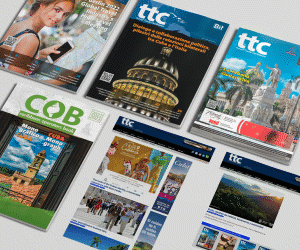Key technology trends for the MICE industry in 2024

By: José Enrique Salgado Febles, PhD.
Meetings, incentives, congresses and exhibitions tourism, generally known as MICE, has recovered from practically zero following the pandemic years. This type of tourism, considered the thirteenth most important economic activity in the sector worldwide, with a revenue of 2.5 trillion dollars, employs close to 2.5 million people, according to a report by Entorno Turístico.
The number of international association congresses doubled in the last seven years, despite the pandemic, from just over 12,000 in 2016 to about 24,000, according to the International Congress and Convention Association (ICCA), marking the growth trend of the last five decades. In Latin America, MICE comprises 8-9% of total tourism activity, demonstrating its profitability and growth.
But this trend does not ensure a steady flow of visitors and tourists for all destinations, brands or companies in the tourism sector in general, and MICE in particular. Competition is increasing and the scenario is becoming increasingly globalized, with new technologies playing a fundamental role.
Various stakeholders are involved in Meeting tourism, in addition to and combined with the usual ones (agencies, hotels and carriers).
| Event generators: | Organizations, associations, foundations, professional bodies, universities, and public and private companies that require the organization and hosting of any type of meeting or professional event. |
| Professional operators | Specialized travel agencies with departments dedicated to the organization of events and meetings, both domestically and abroad. With a specialized professional conference organizer (PCO) service. |
| Destination convention bureau or dept. | Organizations whose main objective is to attract business and events tourism to the region, city or country, created by governments and with the participation of chambers of commerce, ministries and other public-private entities. These can be independent or inserted in destination management organizations or local governments.
They provide updated and objective information on the infrastructure and services that the destination offers for MICE tourism. |
| Fairgrounds, convention centers and halls:
|
These are the sites where MICE events take place. The data shows that convention centers are the favorite venues for large events, but convention hotels rank second and come first for incentive travel. |
Table 1. Meeting Tourism Stakeholders.
The training and capacity for interaction, coordination and integration of these four stakeholders and others in the tourism value chain is essential to successfully attract, organize and develop different MICE events.
(textos de imagen: Hotels, Resorts ; Transport ; Attractions ; Equipment and Infrastructure Facilities)

Fig. 1 MICE Tourism Value Chain Stakeholder Interaction (Source: Cybage)
Key Success Factors (KSF) in MICE Tourism
There are seven key factors or aspects for success and improving international positioning in the MICE meetings segment.
| 1 | Mktg and Promotion of the MICE Destination |
| 2 | Partnerships with associations and event and incentive generators |
| 3 | Air connectivity and transportation |
| 4 | Adequate infrastructure for MICE tourism |
| 5 | Hotel infrastructure and tourist attractions |
| 6 | Training and specialization of personnel |
| 7 | Adequate design and organization of MICE activities |
Table 2. Key Success Factors in Meetings Tourism.
New information and communication technologies have a significant impact on each of these factors.
Today, destinations and the various entities involved in meetings tourism are facing a hyper-connected traveler for whom the ease of Internet access at the destination, the meeting or accommodation venue, and access to new technologies are more important when deciding where to travel to or organize an event, ensuring they can use their devices as they usually do in their place of origin.
The task of improving the MICE customer experience before, during and after their “meeting” must be the ultimate goal of all innovation initiatives involving the participants in this value chain, in order to meet the expectations of people who are increasingly accustomed to using these technologies in their daily lives. In fact, attracting participants in the business tourism value chain of the future will require a high degree of adaptation in the face of changing scenarios and new, “more technological” user profiles.
Let’s take a look at some of the technologies to consider:
- Promotion and marketing of tourism development at the destination, supported by policies, authorities and the community.
- Relationships with the scientific, professional and business community, religious and cultural institutions at the local and national level that also connect them internationally are key to identifying opportunities and attracting and hosting international meetings and events, as well as national events that in turn attract the foreign tourists or exhibitors. Relationships or membership in organizations such as ICCA are of great importance.
- International air connectivity and adequate domestic transportation infrastructure.
- Specialized infrastructure for the hosting of modern MICE activities, adapted to the new audiovisual and ICT technical developments.
- Hotel infrastructure and tourist attractions, as well as the adequate facilitation of access to this offer through travel agencies both within and beyond the destination.
- Training of all personnel, both that of PCOs and those involved across the segment’s value chain, to enhance services for Meeting tourists.
- Proper design and organization
The pandemic has left us with the usual “hybrid” events, where in-person speakers and attendees converge and coexist with a number of virtual speakers and attendees. It is necessary to plan with this in mind, and to assimilate cloud-based event management systems that allow organizers to coordinate and control all aspects of the event from anywhere in the world and access attendee information in real time.
Finally, once the events, trade shows, conventions and incentive meetings are over, we are left with a huge amount of operational data and more potential customer contacts for further marketing actions, but also the space for data analysis opens up.
Big Data techniques and Artificial Intelligence enable real-time data collection and analysis during MICE events. Organizers can obtain valuable information about the participation of tourists and attendees, their preferences, the most visited stands, the most popular exhibitors, the “bleisure” attractions with greater demand and other aspects. With this data, organizers can make informed decisions for future actions, design better meetings and events and enhance the attractiveness of the destination for more efficient future MICE events.

MORE NEWS










